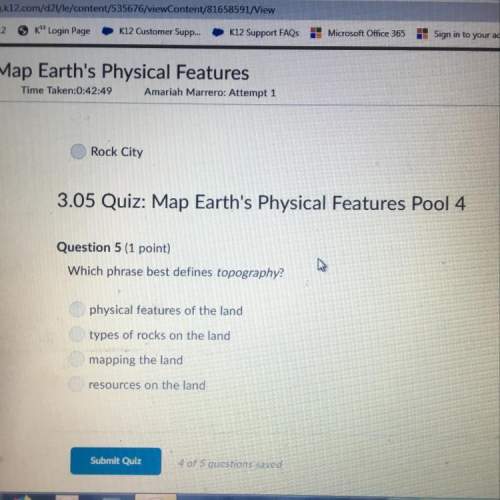Question 1(multiple choice worth 3 points)
(07.05 lc)
when zinc reacts with...

Chemistry, 15.11.2019 03:31 aubreyfoster
Question 1(multiple choice worth 3 points)
(07.05 lc)
when zinc reacts with hydrochloric acid, it produces hydrogen gas. as the reaction proceeds, why does the rate of production of hydrogen gas decrease?
the concentration of hydrogen gas decreases.
the concentration of the reactants decreases.
the hydrogen gas formed inhibits the reaction.
the hydrogen gas also reacts with the zinc metal.
question 2(multiple choice worth 3 points)
(07.05 lc)
which of the following is true about catalysts?
catalysts increase the number of collisions that occur between reactants.
catalysts increase the activation energy by forming new reactants.
catalysts reduce the potential energy of the compounds that are produced.
catalysts reduce the energy needed for the reaction to take place.
question 3(multiple choice worth 3 points)
(07.05 lc)
according to the collision theory, which of the following changes would increase the rate of a reaction between vinegar and sodium hydroxide?
cooling the sodium hydroxide
increasing the volume of the container
diluting the vinegar
heating the vinegar
question 4(multiple choice worth 3 points)
(07.05 mc)
the graph shows the distribution of energy in the particles of two gas samples at different temperatures, t1 and t2. a, b, and c represent individual particles.
a graph is shown with two inverted graph curves running close to each other. one of the curves labeled t1 is slightly more spread out than the other labeled t2. the x axis of the graph has the title kinetic energy. the y axis of the graph has the title number of particles. a vertical line perpendicular to the x axis is shown. this vertical line is labeled activation energy. a point labeled b is shown on the right hand side of the vertical line. a point labeled a is shown in the lower left side of the vertical line. a particle labeled c is shown in the upper left side of the vertical line.
based on the graph, which of the following statements is likely to be true?
particle a is more likely to participate in the reaction than particle b.
particle c is more likely to participate in the reaction than particle b.
the number of particles able to undergo a chemical reaction is less than the number that is not able to.
more gas particles participate in the reaction at t2 than at t1.
question 5(multiple choice worth 3 points)
(07.05 mc)
the table shows the concentration of a reactant in the reaction mixture over a period of time.
reactant concentration
time concentration
0 s 1.8 m
210 s 1.2 m
450 s 0.8 m
580 s 0.6 m
720 s 0.4 m
what is the average rate of the reaction over the entire course of the reaction?
1.6 × 10−3
1.9 × 10−3
2.0 × 10−3
2.2 × 10−3
question 6 (essay worth 5 points)
(07.05 hc)
in an experiment, sulfuric acid reacted with different volumes of sodium thiosulfate in water. a yellow precipitate was formed during the reaction. a cross drawn at the base of each flask became gradually invisible due the formation of this yellow precipitate. the time taken for the cross to become invisible was recorded. a partial record of the experiment is shown.
experimental record
flask volume of
h2so4 volume of
sodium thiosulfate volume of
water time
1 5 ml 50 ml 0 ml 19 seconds
2 5 ml 40 ml 10 ml
3 5 ml 30 ml 20 ml
4 5 ml 20 ml 30 ml
based on your knowledge of factors that affect the rates of chemical reactions, predict the trend in the last column of the experimental record. use complete sentences to explain the trend you predicted. you do not have to determine exact values for time; just describe the trend you would expect (increase or decrease) and why it occurs.

Answers: 1
Another question on Chemistry

Chemistry, 22.06.2019 10:00
Drug abuse will not lead to physical and psychological dependence. true or false ?
Answers: 2

Chemistry, 22.06.2019 11:40
Modern pennies are composed of zinc coated with copper. a student determines the mass of a penny to be 2.482 g and then makes several scratches in the copper coaling (to expose the underlying zinc). the student puts the scratched penny in hydrochloric acid, where the following reaction occurs between the zinc and the hcl (the copper remains undissolved): zn(s) + 2 hcl(aq) → h2(g) + zncl(aq)the student collects the hydrogen produced over water at 25 °c. the collected gas occupies a volume of 0.899 l at a total pressure of 79 j mmhg. calculate the percent zinc (by mass) in the penny. (assume that all the zn in the penny dissolves.)
Answers: 1

Chemistry, 22.06.2019 14:20
7. in the cycle, a virus integrates its dna into the host's dna, and its dna is replicated when the host dna is replicated. a. infectious b. retroviral c. lysogenic d.lytic
Answers: 1

Chemistry, 22.06.2019 17:30
Upon decomposition, one sample of magnesium fluoride produced 1.65 kg of magnesium and 2.56 kg of fluorine. a second sample produced 1.32 kg of magnesium. part a how much fluorine (in grams) did the second sample produce?
Answers: 2
You know the right answer?
Questions

Mathematics, 18.06.2021 03:00



History, 18.06.2021 03:00



Biology, 18.06.2021 03:00

Mathematics, 18.06.2021 03:00

Mathematics, 18.06.2021 03:00

Mathematics, 18.06.2021 03:00

Mathematics, 18.06.2021 03:00

Social Studies, 18.06.2021 03:00



English, 18.06.2021 03:00

Biology, 18.06.2021 03:00


Mathematics, 18.06.2021 03:00

Mathematics, 18.06.2021 03:00




